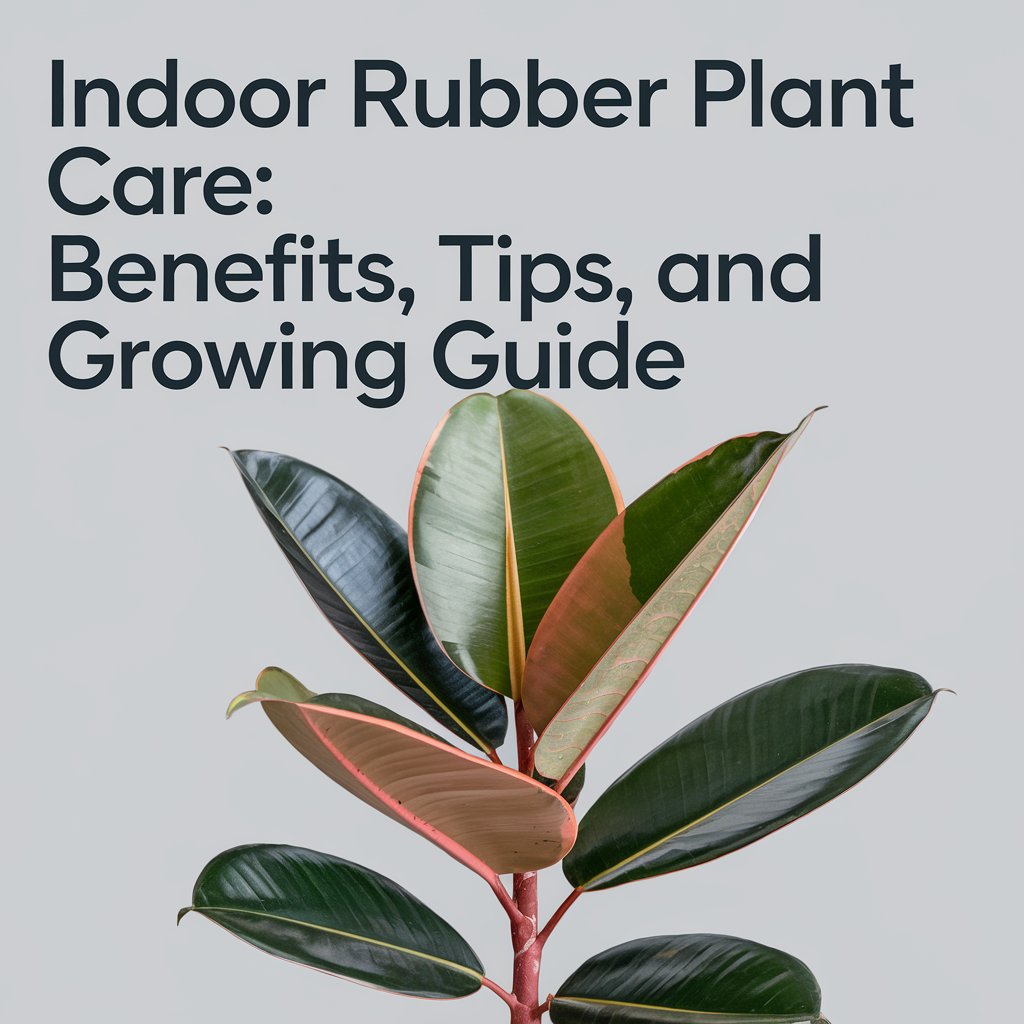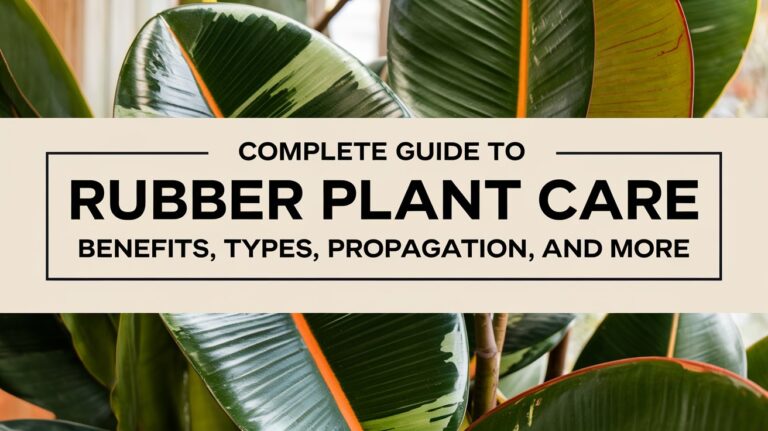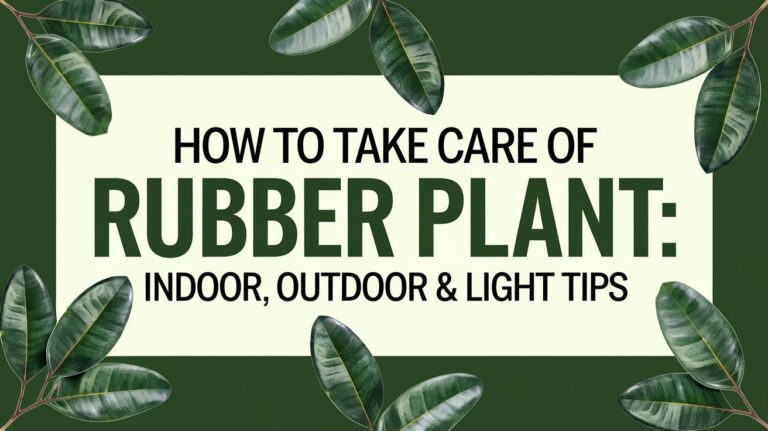When it comes to low-maintenance indoor plants that make a bold statement, the Rubber Plant (Ficus elastica) is hard to beat. With its glossy leaves and impressive size, this plant is a favorite among beginners and seasoned plant enthusiasts alike. But if you’re wondering, is the Rubber Plant an indoor plant or an outdoor plant?—the answer is both! While it can thrive outdoors in tropical climates, the Rubber Plant truly shines as an indoor plant. In this blog, I’ll share the indoor Rubber Plant benefits, practical care tips, and everything you need to know about how to grow a Rubber Plant indoors..
Benefits of Growing a Rubber Plant Indoor
Let’s start with why you should have a Rubber Plant indoor in the first place.
1. A Natural Air Purifier
Did you know one major benefit of Rubber indoor plants is their ability to clean the air? Rubber Plants are excellent at removing toxins like formaldehyde, making them a natural way to improve indoor air quality. This was one of the main reasons I decided to add a large indoor Rubber Plant to my home.
2. Aesthetic Appeal
The Rubber Plant height indoors can range from a modest table-top plant to a tall tree-like centerpiece. Its glossy, vibrant leaves instantly elevate any room’s décor. Whether it’s a corner of your living room or your office desk, an indoor Rubber tree plant makes the perfect statement piece.
3. Low Maintenance
Another great indoor Rubber Plant benefit? It’s incredibly low-maintenance. Once you know the basics of how to take care of a Rubber Plant indoor, you’ll find it’s a forgiving and rewarding plant to grow.
How to Take Care of a Rubber Plant Indoor
When I first started with my Rubber fig indoor plants, I didn’t know much about their care requirements. Over time, I’ve learned the essentials of Rubber tree plant care indoors, and I’m excited to share them with you.
1. Light Requirements
One of the first things people ask is, is the Rubber Plant indoor or outdoor? While it can grow outdoors in the right conditions, it thrives as an indoor plant with the right lighting. Rubber Plants prefer bright, indirect sunlight. Avoid direct sunlight as it can scorch their leaves. If you don’t have enough natural light, a grow light can work wonders for your indoor plant Rubber tree.
2. Watering Routine
Knowing how often to water an indoor Rubber Plant is key to keeping it healthy. Water your plant when the top 1-2 inches of soil feels dry. Overwatering can lead to root rot, while underwatering can cause leaves to droop. In my experience, watering every 7-10 days works well, but this can vary depending on your home’s humidity and temperature.
3. Humidity and Temperature
Rubber Plants love warm, humid conditions. If the air in your home is dry, consider misting the leaves or using a humidifier. Keep the temperature between 65°F and 85°F for best results.
4. Soil and Potting
For caring for Rubber Plants indoors, use well-draining soil. A mix of potting soil and perlite or sand works great. Also, ensure your pot has drainage holes to prevent waterlogging.
5. Pruning and Maintenance
If your indoor Rubber Plant grows too tall, don’t hesitate to prune it back. Pruning encourages bushier growth and keeps the plant manageable. I prune my large indoor Rubber Plant every spring to maintain its shape.
How to Grow Rubber Plant Indoor: Practical Tips
If you’re new to Rubber Plants, here are a few tips to help you master how to grow Rubber Plant indoor:
- Placement Matters: Keep your plant near a bright window but out of direct sunlight.
- Clean the Leaves: Dust can accumulate on the glossy leaves, so wipe them with a damp cloth to keep them shiny and healthy.
- Fertilize Occasionally: Feed your plant with a balanced liquid fertilizer every month during the growing season (spring and summer).
Troubleshooting Common Issues
Even with the best care, you might encounter a few challenges with your indoor Rubber tree plant. Here are some solutions to common problems:
- Drooping Leaves: This could be due to under watering or low humidity. Adjust your watering routine or mist the plant regularly.
- Yellowing Leaves: This usually indicates overwatering or poor drainage. Make sure your soil isn’t waterlogged.
- Leggy Growth: If your plant is stretching out with sparse leaves, it’s not getting enough light. Move it to a brighter spot.
FAQs About Rubber Plant Indoor Care
Is the Rubber Plant an indoor plant?
Yes, Rubber Plants thrive indoors when given the right conditions, making them one of the most popular houseplants.
How to care for a Rubber Plant indoor?
Yes, Rubber Plants thrive indoors when given the right conditions, making them one of the most popular houseplants. Provide bright, indirect sunlight, water when the soil is dry, and maintain warm, humid conditions.
How often do you water an indoor Rubber Plant?
Water every 7-10 days, or whenever the top 1-2 inches of soil feels dry.
Can the indoor Rubber Plant produce rubber?
While it’s true that Rubber Plants were once used to produce latex, your indoor plant likely won’t produce enough to be noticeable.
How tall can a Rubber Plant grow indoors?
With proper care, a Rubber Plant can reach up to 8-10 feet indoors. Regular pruning can help control its height.
Conclusion
Growing a Rubber Plant indoor is incredibly rewarding. Not only does it add beauty to your space, but it also offers numerous indoor Rubber Plant benefits, from air purification to stress reduction. By following these simple tips on how to care for a Rubber Plant indoors, you’ll have a thriving plant that’s sure to be the star of your indoor garden.
So, whether you’re a seasoned plant parent or just getting started, give the indoor plant Rubber tree a try—you won’t regret it! And remember, a little attention goes a long way in keeping your Rubber Plant happy and healthy.
Hi, I’m Pritesh, the heart and hands behind Roots & Earth. My love for plants started when I was just 5 years old, planting trees alongside my grandfather. Those early experiences in the garden left a lasting impression, shaping my deep connection to nature and sparking a lifelong passion for nurturing green spaces.
With an MBA under my belt, I’ve blended my business acumen with my love for gardening, creating Roots & Earth as a way to share my knowledge and inspire others. When I’m not working in my own home garden, you’ll find me traveling to the mountains—my favorite getaway for reconnecting with the natural world.
At Roots & Earth, I’m here to guide you on your gardening journey, whether you’re a seasoned green thumb or just starting out. Together, let’s cultivate beautiful, thriving spaces that enrich our lives and the earth.




